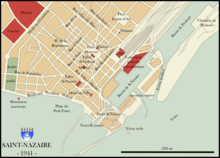Form Joubert

The Forme Joubert ( German Joubert-Dock ) is a dock lock at the port of the French city of Saint-Nazaire . The dry dock became known through the British command company Operation Chariot in 1942. The building bears the name of Louis Joubert, who died in 1930, who was the chairman of the Chamber of Commerce of Saint-Nazaire, who campaigned for its construction.
The docks in the port facilities were no longer sufficient for the completion or construction of the large passenger ships Île de France and Normandie . Therefore, in February 1929, construction of a larger dock began. The 350 m long, 50 m wide and 16.60 m high chamber received a gate at both ends and could therefore also be used as a lock between the Bassin de Penhoët harbor and the mouth of the Loire on the border with the open sea. The gates were each built from 51 m long and 11 m wide hollow steel parts in the "caisson-and-camber" style. 700 workers were employed on the construction site, on October 29, 1932 the Forme Jobert was inaugurated. The Normandy remained from keel laying to launch in 1935 40 months of aging in the new dock.
During the German occupation of France in World War II , the Navy built a base with a submarine bunker in Saint-Nazaire . The Forme Joubert, for its part, turned out to be large enough to accommodate and service the German battleships Bismarck and Tirpitz of the Bismarck class . With Operation Chariot , the Royal Navy succeeded in preventing its possible use in the Atlantic while avoiding the passage through the English Channel . Supported by 35 Whitley and 25 Vickers Wellington bombers, British elite soldiers attacked Forme Joubert on the night of March 28, 1942 with the modified destroyer HMS Campbeltown , a gunboat as a lead ship and wooden motor launches each holding 15 soldiers . The resistance group Confrérie Notre-Dame provided essential information for planning the company .
At 1:34 a.m., Campbeltown, occupied by only 75 men, rammed the southern lock gate at a speed of around 20 knots . Behind the main gun of the destroyer 24 included in steel and concrete were water bombs placed, which should be activated by several chemical time fuse. These explosive charges were supposed to explode around 9 a.m., but this did not happen. However, the British soldiers managed to destroy the other infrastructure of the dock such as the pump systems.
The Germans who examined the ship wedged in the gate did not find the explosives. When it did explode around 10:35 a.m., it destroyed the gate and at the same time killed 250 soldiers and civilians. This made the dock unusable for the remainder of World War II .
After the repair, it was the formerly German passenger steamer Europa at the end of the 1940s , which was the first ship to be repaired in the Forme Joubert under the new name Liberté . Today's pumps can empty the 273,000 m³ water chamber within twelve hours. In 2010 the southern lock opening received a new gate.
For the construction of even larger ships such as the Supertanker and the Queen Mary 2 , Basin C replaced Forme Joubert as the largest dock in Saint-Nazaire in the 1970s. It has a length of 450 m and a width of 150 m.
Web links
Individual evidence
- ↑ Noël Brloëlec: The Brittany . Parkland, Stuttgart 1988, ISBN 3-88059-294-2 , p. 104 .
- ↑ a b c Question: la forme Joubert, c'est quoi au juste? at actu.fr, accessed on February 21, 2020
- ↑ Saint-Nazaire: dans les entrailles de la forme Joubert at france3-regions.francetvinfo.fr, accessed on February 21, 2020


